Abstract
Solar irradiance is an available resource that could support electrification in regions that are low on socio-economic indices. Therefore, it is increasingly important to understand the behavior of solar irradiance. and data on solar irradiance. Some locations, especially those with a low socio-economic population, do not have measured solar irradiance data, and if such information exists, it is not complete. There are different approaches for estimating solar irradiance, from learning models to empirical models. The latter has the advantage of low computational costs, allowing its wide use. Researchers estimate solar energy resources using information from other meteorological variables, such as temperature. However, there is no broad analysis of these techniques in tropical and mountainous environments. Therefore, in order to address this gap, our research analyzes the performance of three well-known empirical temperature-based models—Hargreaves and Samani, Bristol and Campbell, and Okundamiya and Nzeako—and proposes a new one for tropical and mountainous environments. The new empirical technique models daily solar irradiance in some areas better than the other three models. Statistical error comparison allows us to select the best model for each location and determines the data imputation model. Hargreaves and Samani’s model had better results in the Pacific zone with an average RMSE of , , and . The new proposed model showed better results in the Andean and Amazon zones with an average , , , and . Another result was the linear relationship between the new empirical model constants and the altitude of 2500 MASL (mean above sea level).
1. Introduction
Solar energy is a promising renewable energy source for supplying the growing energy demand. It has taken decades for solar energy to become economically feasible in developing countries. Today, the associated cost of harnessing this energy resource is competitive in certain situations, such as rural and isolated electrification. In isolated and rural areas, low population density discourages investments for expanding electricity transport systems due to uncertainty in the profits. The state could face such limitations in ensuring access to electricity services for rural and isolated populations through non-conventional energy sources, such as solar energy. In developing countries, solar irradiance data are often unavailable because of the scarcity of weather stations that measure this variable and the insufficient or incomplete calibration and maintenance of metering equipment [1]. In some cases, even when open-access databases are available, information gathering is extensive [2]. Therefore, in recent years, studies analyzing the correlation and methods for estimating solar insolation have increased. Empirical models incorporate relevant variables, such as temperature, sunshine, and relative humidity, to estimate solar insolation, as academic literature shows. The choice of the weather variable to estimate solar irradiance depends on available information, which is temperature in this case. We selected temperature because variable data were available in the national database, and AWS measured temperature and solar irradiance simultaneously in the analyzed locations.
1.1. Background
From empirical models to artificial intelligence, researchers develop models to estimate solar insolation for different time frames. Simplicity, acceptance, adaptability, and low computational cost are the advantages of empirical models [3]. Empirical models are usually based on astronomical, geometrical, physical, and meteorological factors [4]. The meteorological factors include the cloudiness, temperature, and sunshine that describe the condition of the sky. Of these, cloudiness is the most crucial factor for determining solar irradiance behavior. The databases record sunshine duration and temperature [5]; consequently, these variables are most widely used to estimate solar insolation [2]. The implementation of the empirical model depends on data availability and consistency [6]. Given this, the authors of [7] recommend revising the study site’s data simultaneity and reliability. In this case, all the weather stations recorded temperature data. Therefore, temperature-based empirical models are a convenient option for estimating global solar insolation [8].
In 1982, Hargreaves and Samani presented the first temperature-based model for estimating solar insolation based on daily temperature differences [9]. In 1984, Bristow and Campbell proposed a temperature-based empirical model that inputs the difference between daily maximum and minimum temperatures [10]. In 2011, Cheng et al. evaluated the performance of the temperature-based models in China. They found that support vector machine models using maximum and minimum temperatures as input and polynomial kernel functions outperform empirical models [11]. In 2014, Li et al. presented a temperature-based model for China based on the Hargreaves and Samani model [12]. Quansah et al. evaluated temperature-based and sunshine-based empirical models in Ghana [13], and Dos Santos et al. assessed nine temperature-based models for Brazil [14]. In 2017, Rivero et al. validated Hargreaves and Samani’s model for Mexico [15], while Jamil and Akhtar compared empirical models for India’s subtropical and humid environments [16]. Although several studies analyzed the empirical models’ behavior in different places globally, there is no similar amount of research analyzing the efficacy of temperature-based models for tropical and mountainous environments.
1.2. Contribution
To this end, the purpose of this research study was to assess three empirical temperature-based models—Hargreaves and Samani (HS), Bristow and Campbell (BC), and Okundamiya and Nzeako (ON)—for their capacity to estimate solar insolation in a tropical and mountainous environment. Statistical validation determines and compares the performance of the three models. Additionally, we proposed a new method based on the logistic regression model in order to estimate daily solar insolation according to daily temperature differences. This new approach offers an option to estimate daily solar insolations based on the temperature difference that could improve the estimation of this resource in sites with different latitudes with low computational costs. The IDEAM’s (Institute of Hydrology, Meteorology and Environmental Studies, abbreviated IDEAM according to its Spanish translation) Automatic Weather Stations (AWSs) located in the State of Nariño, Colombia, measured the information used as input. The three environmental zones of the area, Pacific, Andean, and Amazonian, allowed evaluating the models in different weather and physiographic conditions. The database was randomly divided into two parts: the first for calibrating the models and the second for validating the models statistically. Before using the empirical models, the data passed a quality control procedure to improve the reliability of the results. R-CRAN was the software used to carry out the computational process needed for the research.
1.3. Paper Structure
The article is organized into the following sections: Section 2 describes the materials and methods used; Section 2.1 describes the characteristics of the dataset; Section 2.2 and Section 2.3 outline the quality control procedures applied to both solar irradiance and temperature data; Section 2.4 presents the empirical temperature-based models; Section 2.3.4 introduces the author’s proposed model; Section 2.4 assesses the statistical validation of empirical models; Section 3 presents the results and discussion; and finally, Section 4 presents the conclusions.
2. Materials and Methods
2.1. Site and Dataset
The weather stations located in Nariño, Colombia (00°31′08″ N and 02°41′08″ N latitude; 76°51′19″ W and 79°01′34″ W longitude), measured solar irradiance and temperatures used as input for the empirical models. The proximity to the Equator and the Intertropical Convergence Zone influences the weather of this place, causing unimodal or bimodal rainy seasons and increasing cloud cover due to high humidity in low altitudes. Additionally, the western mountain range is a barrier for the moist air masses from the Pacific Ocean; thus, the Pacific foothills become more humid and tend to maintain this humidity [17]. Hence, it is appropriate to divide the weather and orographic conditions of Nariño into three environmental regions: the Pacific, the Andean, and the Amazon [18].
The Pacific zone covers 52% of the total territory of Nariño, and this zone includes the Mira-Mataje binational watershed and a mangrove forest located in the Sanquianga natural reserve. Additionally, the region has two climatic zones: the Pacific flatlands and the Pacific foothills. The Pacific flatlands have a humidity level higher than 80%, an average temperature higher than 26 °C, and annual precipitation of between 3000 and 5000 mm/year. The Pacific foothills have high humidity, an average temperature between 18 °C and 24 °C, and annual precipitation between 4000 and 6000 mm/year. However, between the Junín and Barbacoas localities, the annual precipitation is approximately 9000 mm/year [17,18,19]. The Andean zone constitutes 40% of the total area of Nariño, and in this zone, the Andes split into two ranges: western and central [17,20]. The western mountain range exhibits bimodal precipitation behavior between 800 and 2200 mm/year, with peaks in April–May and October–November. In the central mountain range, the temperatures vary between 16 °C to 24 °C, and precipitation averages between 1000 to 1800 mm/year. In the north zone toward Patia, annual precipitation is less than 1000 mm/year, with temperatures typically above 24 °C [19]. The Amazon zone covers 8% of the Nariño territory and has two climate zones: mountainous and flatland. The mountainous zone is located between the Patía and Putumayo rivers with temperatures averaging between 6 °C and 11 °C and annual precipitation of about 2000 mm/year. The flatland zone has tropical weather influenced by the cloudy jungle and precipitation between 500 to 1500 mm/year [19].
There are 9 AWSs measuring solar irradiance, 8 located in Nariño and 1 positioned in the neighboring state of Cauca, and 16 Conventional Weather Stations (CWS) measuring temperature (see Table 1 and Table 2), located as shown in Figure 1. In the Pacific region, there are three AWSs. The altitude of these AWS ranges between 16 and 512 MASL. In the Andean region, there are five AWSs located at altitudes between 1005 and 3120 MASL. Finally, in the Amazon region, there is one AWS at an altitude of 3577 MASL. The maximum altitude difference between all AWSs is 3561 MASL. This difference allows evaluating solar irradiance behavior in a wide range of altitudes in the three diverse environmental regions. We reviewed a study on the same zone that used Landsat 7 (1999–2015), MODIS (2005–2015) and VAISALA 3TIER (2000–2015) satellite data; however, when comparing the satellite and ground data, we found a significant difference between them. The satellite data resulted in a maximum solar irradiance potential of approximately 245 W/m2 day with MODIS and Landsat 7 database [21]. In contrast, the ground measurements show a maximum potential of approximately 3800 W/m2 day. Furthermore, the results of the national Solar Atlas are closer to our results than satellite ones.

Table 1.
Automatic weather stations in Nariño.

Table 2.
Conventional weather stations in Nariño.

Figure 1.
Automatic and conventional weather stations in Nariño. Source: made by the authors with information from OpenStreetMap.
2.2. Data Quality Control
Data quality control is a procedure intended to improve the reliability of time series data. The procedure includes the analysis of database structure, the comparison with fixed and flexible limits, and time consistency. The application of these steps offered reliable results in studies of weather data quality control in Spain [22]. The quality control procedure followed in the current research study relied on guidelines presented in regulation UNE500540, which outlines successive analytical procedures of quality control for different weather variables [23]. The first step consists of checking the database structure, the second step compares the data with the maximum extraterrestrial solar irradiance, the third step compares the time series with the maximum and minimum clear-sky global solar irradiance limits, and the fourth step consists of analyzing changes in global solar irradiance hour by hour.
2.2.1. Solar Irradiance Data Quality Control
The first step consists of checking database structure. In our case, the data exhibited the following structure: AWS code, weather variable code, date, hour, and value. This step only maintains the values with the described structure [15]. For the fixed-range step, UNE500540 suggests using the most restrictive condition between the measurement device limit and the physical phenomenon limit. Nariño’s AWS have Kipp & Zonen CMP11 pyranometers with an upper operation limit of 4000 [24]. The physical limit is the maximum extraterrestrial solar irradiance of each location computed with the following equation [25]:
where is the solar constant, is the Julian day, is the solar altitude, and is the declination calculated as follows:
where is the latitude, and is the hour angle calculated as follows.
Therefore, the most restrictive condition is the extraterrestrial solar irradiance [22]. Consequently, , where is the measured global solar irradiance by a pyranometer at time .
For the flexible range test, UNE500540 suggests comparing the time series with the maximum and minimum values of a validated time series. In this case, there was no time series previously validated; therefore, we used, as an alternative, the restriction proposed for Estévez et al. with one modification. Namely, instead of using , we used the following range defined by the clear-sky global solar irradiance: [21]. The clear-sky global solar irradiance is equal to times , , and is the atmospheric transmittance estimated with Kreith and Kreider’s model as follows [25]:
where the air mass is defined as follows.
The fourth step consists of analyzing changes in global solar irradiance hour by hour. This analysis, known as time consistency, follows the restriction . Time consistency is a useful means for detecting data storage and connection troubles in the datalogger. A high sampling frequency—for instance, every ten minutes—would increase the effectiveness of the test.
In addition to the tests mentioned above, it is also necessary to consider the zero offset, which results from thermal imbalances in the pyranometer. This phenomenon occurs because the sensor does not absorb any measurable irradiance values in the pyranometer’s spectral range, resulting in erroneous values [24]. It is essential to offset this imbalance because neglecting it would entail underestimated solar irradiance records between 0.7% and 4.3%. Several environmental factors influence the measurement process, so it difficult to correct all measurement instruments in all locations and environments [26]. Although various approaches to correct the zero-offset adapted to specific environmental conditions and instruments exist, the current research did not follow such approaches.
2.2.2. Temperature Data Quality Control
We carried out five temperature validation procedures, structure, range, step, consistency, and persistence, based on the recommendations of Estévez et al. and Rivero et al. The first step consists of verifying the database structure and that of the solar irradiance validation. The range test involves two evaluation methods: the instrumental range method determined by the ROTRONIC HYGROCLIP 2 RTD PT100 with a temperature range between −40 °C and 60 °C and the use of data validation criteria defined by other researchers. Rivero et al. recommended a temperature interval between −50 °C and 70 °C, while Estévez et al. suggested a range of −30 °C to 50 °C. We followed Estévez et al.’s recommendation because it is within the temperature range of the sensor. Likewise, the analysis of the step test, internal consistency test, and persistency test also followed Estévez et al.’s quality control process because it offered promising data analysis results in Spain [22,27].
The step test requires the fulfillment of the following requirements: ; ; ; ; and , where is the air temperature measured at time . Although this evaluation does not consider other climatology aspects that can affect temperature variation, such as humidity, wind speed, cloudiness, and precipitation, the authors of this study applied these restrictions. Another fundamental requirement is that the daily step restriction fulfills the following condition: , where and are the maximum and minimum daily temperatures [26]. Internal consistency assesses the accomplishment of the following conditions: ; ; and . Finally, the persistence test verifies measurement variability; therefore, the data must accomplish the conditions and , where is the day number [22].
2.3. Empirical Temperature-Based Models
Although air temperature is a standard variable measured in weather stations, it has been infrequently used to estimate solar insolation. Temperature started to be relevant in estimating solar insolation when agricultural studies modeled solar insolation to analyze crop production rates. Consequently, researchers from other fields increasingly focus on the maximum, minimum, and mean temperature values in order to model solar insolation [28]. The most traditional models incorporating maximum and minimum temperatures are the Hargreaves and Samani and Bristow and Campbell models [4,10]. Both models are the basis of innovative approaches adapted to specific location conditions [7,12,27,29,30,31,32].
2.3.1. Hargreaves and Samani’s Model
In 1982, Hargreaves and Samani (HS) proposed a linear relationship between the square root of the temperature difference and the fraction between the extraterrestrial and terrestrial global solar insolation for different periods, as follows:
where is the empirical coefficient, is the global solar insolation on a horizontal surface, and is the daily extraterrestrial solar insolation calculated as follows.
This model, however, did not consider the effects of cloudiness, humidity, latitude, elevation, or topography, among others, in the specific location for which the model is used [33,34]. Allen stated that the HS model demonstrates better behavior in a monthly time frame than in a daily time frame because the variables follow a mean trend, resulting in a consistent relationship between and [35].
The empirical coefficient represents the rate of change from the maximum and minimum temperature difference with the ratio between the extraterrestrial and terrestrial solar insolation. Initially, the HS model proposed an empirical coefficient calibrated with an eight-year time series from Central Valley in Davis County, California (see Table 3) [4,9]. They found that a relative humidity above 54% affects the empirical coefficient, and that the maximum and minimum temperature difference is smaller when it is nearly this percentage. As shown in Table 3, in humid regions, the empirical coefficient has a value less than 0.10 while other regions have values higher than 0.16 [9]. A thorough process uses empirical coefficients according to the region under study. Accordingly, Rivero et al. pointed out that using a fixed empirical coefficient for a large area with different regions may result in significant errors because topography influences temperature, the advective environment, and vegetation [15].

Table 3.
Hargreaves and Samani’s empirical coefficients.
2.3.2. Bristow and Campbell’s Model
Bristow and Campbell (BC) presented a model based on two assumptions. The first assumption is that of a linear relationship existing between the absorbed and incoming solar insolation, while the second assumption is that of disregarding the heat flux coming from the soil for a daily period because it is close to zero. However, it is convenient to mention that the sensible heat produced by diurnal temperatures is higher than that produced during the nighttime [10]. This is understandable because solar irradiance heats air masses more due to short-wave radiation, whereas at night, there is less long-wave emission from the Earth to the atmosphere, reducing the temperature [29]. Furthermore, under ideal conditions, the temperature is minimum just before sunrise, resulting in a significant difference between daily maximum and minimum air temperature. This phenomenon permits the modeling of solar insolation as a function of temperature difference [10]. Under these assumptions, the authors presented their model:
where , and are empirical coefficients. represents the maximum ratio between the extraterrestrial and terrestrial global solar insolation ; and determine how soon the model achieves such a maximum by temperature increases . Empirical coefficients represent the regional characteristics from arid to humid environments [10].
Temperature difference depends on the daily maximum and minimum temperatures for a day given in . Bristow and Campbell concluded that the minimum temperature averages of two consecutive days reduces the effect from hot or cold air masses, in turn, avoiding overestimated and underestimated solar insolation values. Accordingly, Dos Santos et al. stated that advection is not a common phenomenon in tropical zones; therefore, the temperature change estimation in these regions is . Dos Santos et al. also highlighted that this equation is better for sites with high altitudes, as in the study case [14].
Another weather effect modifying the solar insolation estimation is rain. The effect of rain decreases, setting equal to 0.75 times the estimated . If is less than by about 2 ºC, the first factor is multiplied by 0.75 [10]. However, when the rainy period is long, the relation between solar insolation and reaches an equilibrium. Therefore, it does not require adjustments [36].
2.3.3. Models Implemented in Tropical Environments
Knowledge of solar irradiance behavior in tropical zones is a mandatory requirement for this research study. The analyzed cases are from Africa (Nigeria Abuja, Benin City, Katsina, Lagos, Nsukka, and Yola), Brazil (Água Branca, Pao de Azucar, Santana do Ipanema, Palmeira dos Índios, Arapicara, Maceió, Corcuripe, and Sao Jose da Laje), and Mexico. Due to the fact that Nariño is in a tropical area, the results from these three cases constitute relevant inputs for the current research.
Okundamiya and Nzeako (ON) proposed a linear model as follows [37]:
where is the monthly average of the ratio between the daily minimum and maximum temperatures , and and are empirical coefficients. The statistical validation of the model yielded a coefficient of determination between 0.809 and 0.952.
Nwokolo and Ogbulezie reviewed empirical models implemented in West Africa in order to compute global solar irradiance. They found that the soft computing models have better accuracy than the empirical models since they can be more easily adapted to several weather conditions. This is because soft computing models allow more inputs, as models or variables, to strengthen their reliability [38].
Dos Santos et al. studied the performance of ten temperature-based models in Northeastern Brazil. They found that the models did not show significant changes after adjusting them concerning the rainy periods’ effects. Dos Santos et al. also concluded that the HS model demonstrates better performance in the hinterlands and interior regions, whereas the BC model showed the best performance in humid and coastal zones [14].
Rivero et al. compared the values of the original empirical coefficients of the HS with new values generated from the model calibrated for Mexico with local data. A notable element of that research was the classification of Mexico’s climate zones using the Köppen–Geiger system. Furthermore, the authors developed another classification based on the clearness index, as shown in Table 4, to support the AWS data. It is useful to remember that the clearness index is the ratio between terrestrial solar insolation and extraterrestrial solar insolation. A relevant conclusion in this respect was that regardless of solar irradiance peaks during the day, it is possible to obtain similar clearness index values. Another notable conclusion was that fixed empirical coefficients result in significant error, especially in zones with a temperature difference below 15 °C. The authors proposed the following equation to overcome the identified issue derived from fixed coefficients [15]:
where is the Hargreaves and Samani equation coefficient.

Table 4.
Daily clearness index classification ranges.
2.3.4. Proposed Empirical Model
The proposed model originated from observing the scatter plot between the clearness index and the daily temperature difference in each AWS. We concluded that the logistic model would offer useful results, because this model has successfully studied human growth, animal and biological processes, energy use patterns, and atmospheric applications [39,40]. The logistic regression commonly describes the relationship between binary variables and a predictor [41]. Although the relationship between extraterrestrial and terrestrial solar insolation does not offer binary results, it varies in a range between 0 and 1. The use of this technique “arises in estimating relationships in which the dependent variable is continuous, but is limited in range” [42]. Manning’s statement describes the relationship between the dependent and independent variables in the proposed model because solar insolation relationships are continuous, and the temperature range is defined by the minimum and maximum temperatures. Logistic regression does not assume that neither variables nor predictors have a normal distribution; this affirmation was another criterion to choose this approach [43].
The logistic regression model is part of the Generalized Linear Model (GLM), which describes the relationship between the mean of the dependent and independent variables with a more complex relationship than . In logistic regression, which is a statistical method, the coefficients have a similar meaning to linear regression; namely, is the log-odds of success at , while is the change in the log-odds of success corresponding to a one-unit increase in [44]. This regression also assumes a linear relationship between the dependent and independent variables’ log-odds [40].
The logistic function came from the logistic model and is represented as follows:
where is the predicted variable, and is a linear sum where is the independent variable, and and are constants [41].
In this case, the temperature change is the predictor variable. Therefore, the proposed model is defined as follows.
2.4. Statistical Validation
Statistical validation is a mandatory step that allows the comparison of the predictor model with real measures to determine the suitability of the model. There are five main validation techniques: subjective assessment, dispersion indicators, overall performance indicators, distribution similitude indicators, and visual indicators [45,46]. We implement the second technique, because it is appropriate when the data have the same time frame, location, and treatment, among other characteristics. This validation technique measures the difference between the modeled and real value. Table 5 shows some measured dispersion indicators, expressed in absolute units or percentages [45].

Table 5.
Error measurements.
3. Results and Discussion
The results and discussion have four subsections. The first subsection presents the quality control results of global solar irradiance. The second subsection shows the results of the temperature data validation procedure. The third subsection contains the empirical coefficients of the HS, BC, and NO models and those of the proposed model. The last subsection comprises the imputation results and the daily solar insolation for the AWS studied.
Figure 2 shows the scheme followed for implementing the models. We obtained the raw data of AWS and conducted a quality control process for data cleaning. Subsequently, we selected the days with at least six measured per day, aggregated the hourly irradiance to estimate the insolation, and chose the maximum and minimum daily temperature. We randomly selected 80% of the data of AWS for empirical model calibration and 20% for statistical validation.
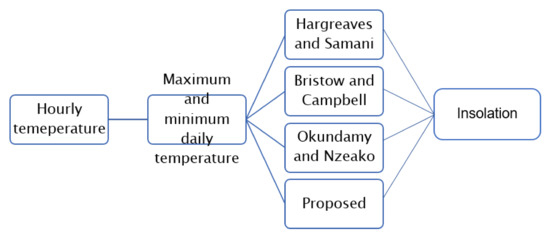
Figure 2.
Scheme for empirical model implementation.
3.1. Quality Control: Global Solar Irradiance and Temperature
A step undertaken prior to the quality control procedure is data adjustment stemming from the calibration constant. In this case, there was no calibration constant for the Biotopo AWS affecting the quality of the time series; likewise, this AWS also had the smallest number of recordings among all AWS. The total amount of data (47,612) for the period studied corresponded to 34.50% of the total data that should be recorded. The AWS registered information during 57.59% of the measured period 2005–2017.
Table 6 shows the results of the global solar irradiance validation procedure. The first step, which evaluated the database structure, presents 5843 recordings on average with the incorrect structure. The AWS with the most recordings that had an incorrect data structure was Viento Libre; this step confirmed that 9715 data did not have the database structure, corresponding to 12.55% of the total data. The AWS with fewer recordings with the incorrect data structure was Biotopo; this step confirmed that 1055 data did have the database structure, corresponding to 2.22% of the total. The fixed range validation discarded 36.71% of data on average. Biotopo lost the most data, corresponding to 47.62% of the total, whereas Universidad de Nariño lost the fewest data, amounting to about 22.09% of the total. The flexible range test results reveal information losses of 39.11%. The AWS with the lowest number of losses was Biotopo, about 15.14%, while Guapi had the highest number of losses, about 5422%. Although the last test was not mandatory, it is useful to point out that 44.06% of the recordings did not overcome the time consistency level. Considering only the mandatory steps, about 35.27% of the data overcame these validation steps. Universidad de Nariño’s AWS had the most data approving the validation process, whereas Guapi’s AWS had the fewest data approving the validation process.

Table 6.
Solar irradiance validation results. Each step represents the amount of data that overcome the validation level.
The first row of Table 7 represents the recorded data number between 06:00 and 18:00. The subsequent rows show the day numbers with the recorded data amount indicated in the heading—for instance, Biotopo has 13 days with only one record. The columns highlighted in gray represent that each day has between 10 and 11 recordings per day. It is worth noting that only 1.26% of days had complete information, with a maximum of 4.25% in Cerro Páramo and a minimum of 0.28% in Biotopo. Consequently, the model implementation only considered the days with at least six recordings during the daytime period to avoid underestimating the resource—approximately 95.81% of the recordings that overcame the mandatory validation levels accomplished this requirement.

Table 7.
Classification of days according to irradiance recording per day. The rows contain the number of days classified by the amount of measured data between the 6:00 and 18:00 per day.
The results confirm the importance of improving the maintenance and calibration procedures of the measurement instruments in order to increase the amount of useful information, in turn increasing reliability.
We considered the Rivero et al.’s classification and modified the item concerning partially cloudy days, as Table 8 shows. Table 8 shows that, in the analyzed AWS, on average, 64.70% of days were classified as partially high cloudiness. This corresponds to losses between 20% and 40% of extraterrestrial solar irradiance when reaching ground level. This result is important not only because clouds affect global solar irradiance but also because, as a variable, it is not easy to model. Consequently, the resource estimation in this tropical and mountainous environment is more complicated than in other environments.

Table 8.
Days’ classification according to cloudiness.
Table 9 shows the results of the temperature validation procedure. In the first step, missing information was 8.64% on average. Cerro Páramo AWS missed the most information amount, with 16.95% missing data. In the fixed range test, Guapi had data missing of about 11.62%. In the step test, about 35.07% of the data did not pass the validation requirement. Considering the starting values as the base, 57.08% of the data overcame the quality control procedure.

Table 9.
Temperature validation results. Each step presents the amount of data that overcome the validation level.
Table 10 shows, as Table 7, the record numbers by day. The results indicate that about 57.42% of the days had 88.46% of useful information. Finally, from the total amount of data that overcame the hourly validation test, only 68.03% of data were suitable for feeding the models.

Table 10.
Classification of days according to irradiance recording per day. The rows contain the number of days classified by the amount of data measured between 6:00 and 18:00.
3.2. Model Development and Performance
3.2.1. Model Development
By observing the scatter plot from Figure 3, Figure 4, Figure 5, Figure 6, Figure 7, Figure 8, Figure 9 and Figure 10, we concluded that the logistic model would offer helpful results because logistic regression commonly describes the relationship between binary variables and a predictor [40]. Although the relationship between extraterrestrial and terrestrial solar insolation does not offer binary results, it varies in a range between 0 and 1. Furthermore, logistic regression does not assume that neither variables nor predictors have a normal distribution [42].

Figure 3.
Daily delta of temperature–clearness index for Biotopo.
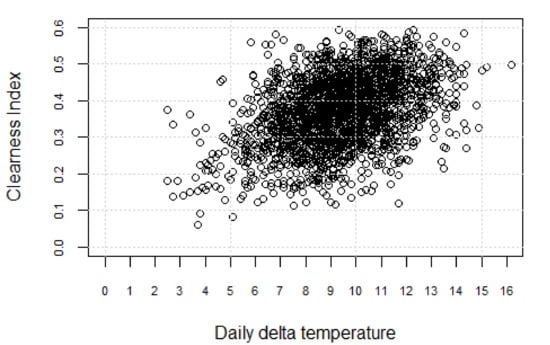
Figure 4.
Daily delta of temperature–clearness index for Viento Libre.
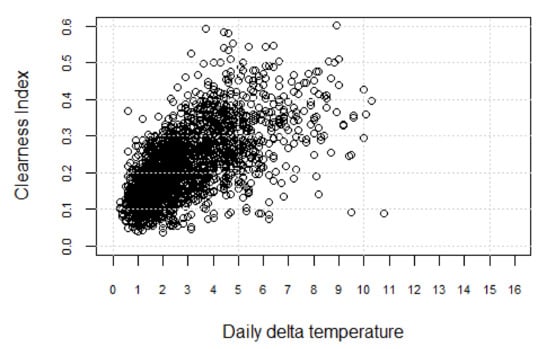
Figure 5.
Daily delta of temperature–clearness index for Cerro Páramo.
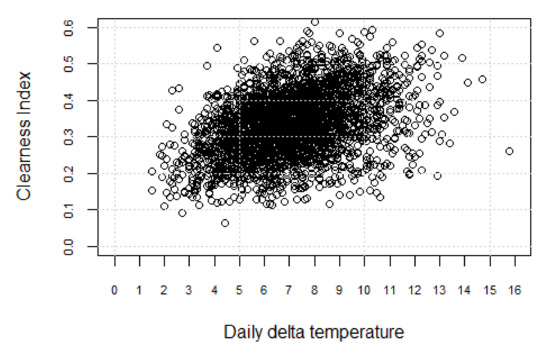
Figure 6.
Daily delta of temperature–clearness index for Universidad de Nariño.
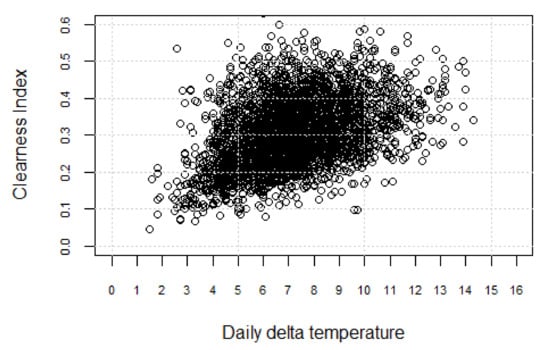
Figure 7.
Daily delta of temperature–clearness index for Botana.
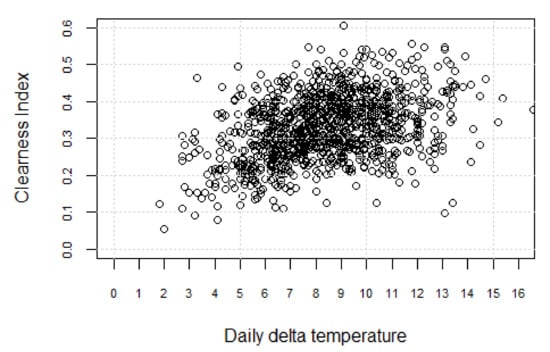
Figure 8.
Daily delta of temperature–clearness index for La Josefina.
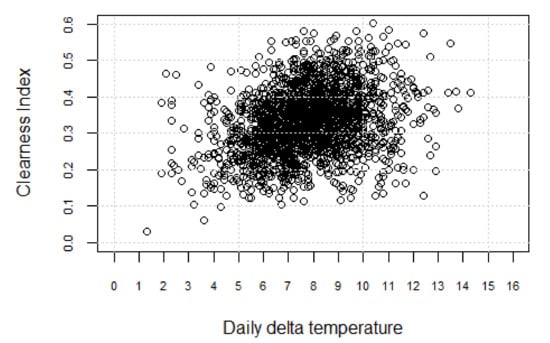
Figure 9.
Daily delta of temperature–clearness index for Paraiso.
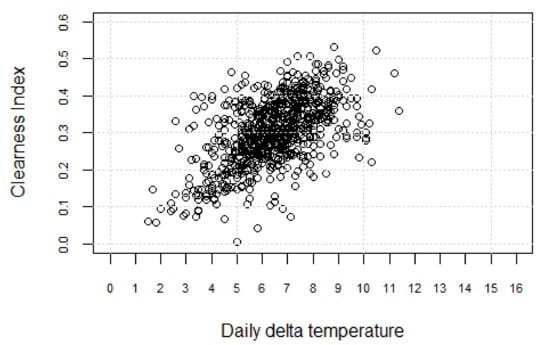
Figure 10.
Daily delta of temperature–clearness index for Guapi.
3.2.2. Performance
Figure 3, Figure 4, Figure 5, Figure 6, Figure 7, Figure 8, Figure 9 and Figure 10 show the relationship between the daily clearness index and daily delta of temperature for the studied AWS. Figure 3 and Figure 10 show that there is a moderate linear relationship between the daily clearness index and daily delta of temperature in the Pacific zone. Figure 5 shows that, in Cerro Páramo, the clearness index and the delta of temperature possess a moderate linear relationship. In the Andean zone, the clearness index and delta of temperature exhibited a weak linear relationship.
Table 11 shows the empirical coefficients of the HS, BC, and ON models and those of the proposed model. The and empirical constants of the BC model demonstrated a growing trend corresponding to altitude, while the c empirical constant showed the opposite behavior. The empirical coefficients of the HS model did not present a significant variation among AWS. This means that the AWSs have similar humid conditions, considering the original values given by [9]. The empirical coefficient of the ON model for the Bitopo AWS revealed the unique negative value. More studies and data are necessary to understand this result. However, there were two influencing factors: Biotopo AWS did not have calibration factor, and the data number was the lowest.

Table 11.
Empirical coefficients.
Table 12 presents the results of seven statistical validation measurements for each AWS. Considering , , , , and , the proposed model had better performance than the other models. That said, the BC model had better results for and . The proposed model showed better results in AWS located at altitudes above 2500 MASL. In contrast, the HS model showed better performance at altitudes below 2500 MASL. However, if the objective is to use a unique model to estimate solar irradiance from temperature data in the state, the proposed model remains the best.

Table 12.
Summary of the empirical model’s statistics results. The best result for each AWS is in bold.
RMSE showed that the lowest value occurred in the Guapi AWS (), while the highest value was in the Cerro Páramo AWS (; on average, RMSE was . The ON model presented the highest RMSE, with ; followed by the BC model, with the HS model, with and the proposed model, with .
The standard deviation showed that Cerro Páramo presented more scattered values than the other AWSs. By comparing the four models and analyzing the average standard deviation, the best option is the proposed model. The MBE showed that the BC model made an underestimation of in Cerro Páramo. All models—ON, HS, BS, and the proposed model—overestimated the solar resource in Viento Libre by , , , and respectively.
The MAE showed that the proposed model had the best performance, with an average error of , while the ON model reached an average error of . yielded, on average, the following results: , and for ON, BC, HS, and proposed models, respectively, thereby confirming that the proposed model performed better than the other models.
presented the BC model as the best-performing model, with on average, whereas the HS model was the worst-performing, with on average. MAPE revealed the proposed model as the best option, with followed by the HS and ON models. The results were consistent with the other statistical results.
The proposed model’s empirical coefficients showed a relationship with altitude. Figure 11 presents the linear adjustment of the empirical coefficients for two altitude ranges covering the location of AWS. On the left side, the figures represent the relationship between empirical coefficients and the altitudes below 2500 MASL; on the right side, the figures show the remaining AWS. Statistical analysis indicated that for the coefficient was 0.5262 and 0.5995 in the first and second cases, respectively. for the coefficient was 0.6069 and 0.8152 in the first and second cases, respectively. This result is remarkable since solar irradiance and temperature change with respect to altitude. These changes occur because of higher altitude and fewer molecules and aerosols scattering and absorbing solar irradiance [47,48].
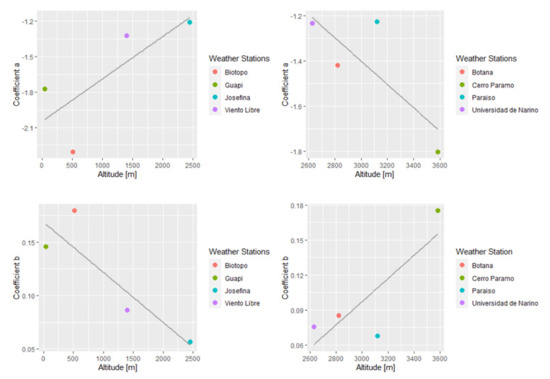
Figure 11.
Coefficients a and b empirical model–altitude relation in the proposed model.
3.3. Imputation of Daily Solar Insolation Data
According to the AWS location, the imputation process used to estimate the daily solar insolation data followed the best empirical model based on the research results. Table 13 shows the number of imputed data for each AWS. La Josefina had the most imputed values; it was necessary to fill in 2870 missing data. Botana had the lowest imputed values, filling 572 missing data. On average, the empirical models allowed imputing about four years of missing data; therefore, it was necessary to fill these empty gaps by using temperature data. The time series before and after the daily solar insolation imputation process for each AWS is presented in Figure 12, Figure 13, Figure 14, Figure 15, Figure 16, Figure 17, Figure 18 and Figure 19.

Table 13.
Imputation by AWS.
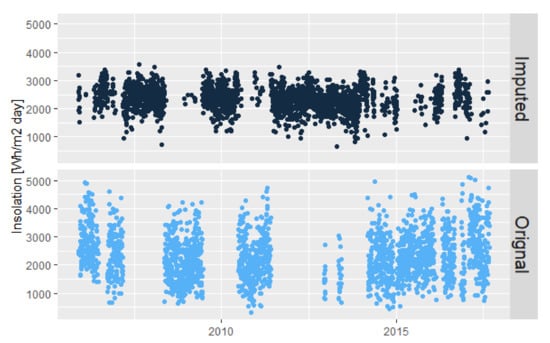
Figure 12.
Biotopo imputation. The dark blue points are the estimated values using air temperature information, and the light blue points are the measured values.
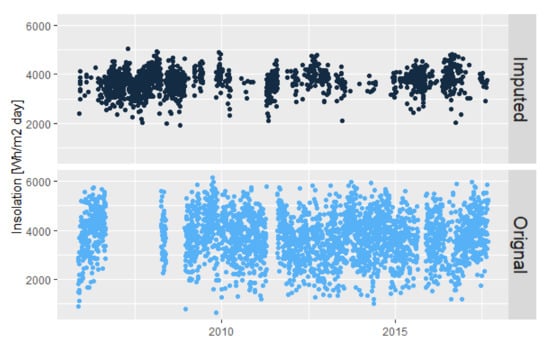
Figure 13.
Viento Libre imputation.
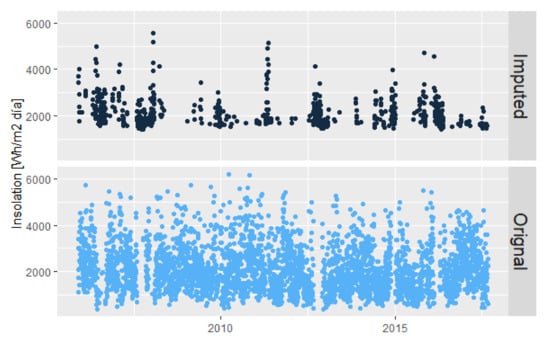
Figure 14.
Cerro Páramo imputation.
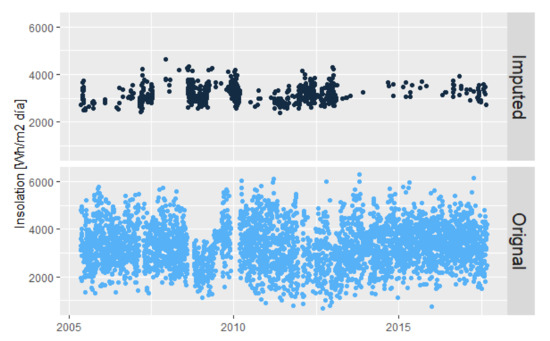
Figure 15.
Universidad de Nariño imputation.
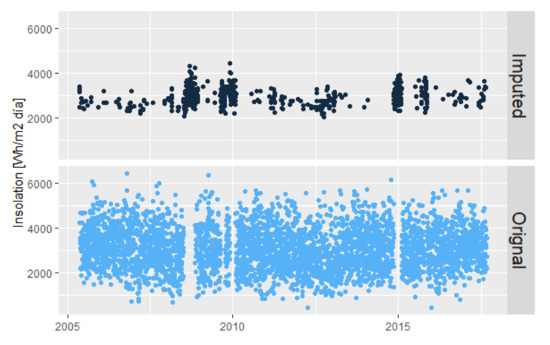
Figure 16.
Botana imputation.
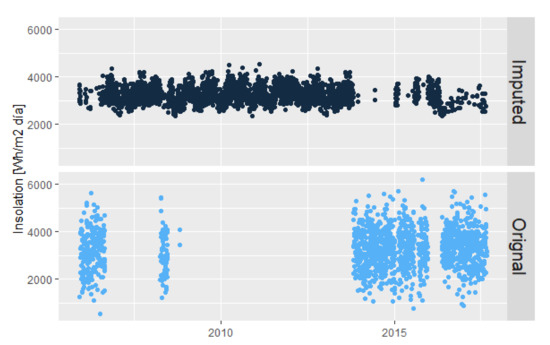
Figure 17.
La Josefina imputation.
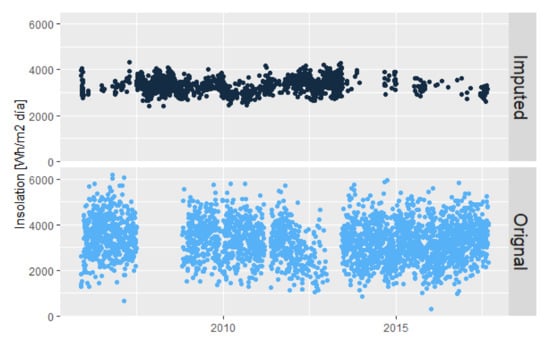
Figure 18.
Paraiso imputation.

Figure 19.
Guapi imputation.
Figure 20 shows the monthly daily average solar insolation for all analyzed AWSs. The AWS located in the Pacific zone presented similar behaviors; namely, they registered a peak in August and September and a lower level in November. Viento Libre was the only AWS that recorded values close to in August. The Botana and Universidad de Nariño AWSs in the Andean region showed a peak between October and November. The Cerro Páramo and Viento Libre AWSs exhibited certain energy complementarity because the lower level in the first AWS compensates the higher level of the second AWS.
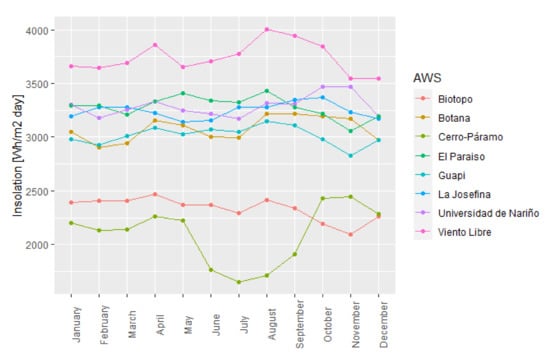
Figure 20.
Daily monthly insolation.
4. Conclusions
The validation levels of the global solar irradiance data strongly influenced the results of the empirical variables. The best evidence was that the results showed that 60.89% of the data overcame the mandatory validation steps. From the dataset overcoming the quality control process, 95.81% corresponded to the days with at least six recordings, and those days constituted the empirical model’s calibration information. However, this percentage represented, on average, 33.90% of the total information recorded in the AWS. In addition to this, only 1.26% of the days had complete information. This result indicates that the time series quality is not optimum; therefore, it is necessary to improve and increase maintenance and calibration procedures.
In the state of Nariño, the performance of the AWS is a determining factor when considering the predominance of partial high cloudiness, representing 64.7% of the total measured days. Accordingly, in Nariño, high cloudiness complicates the estimation of solar insolation; therefore, it is fundamental to improve the reliability of measurement systems. Consequently, it is also essential to regularly establish a plan to carry out these procedures at a high-quality level and according to widely accepted standards. Installing more AWSs to increase the sampling points is also recommended.
Regarding temperature measures, only 92.78% of the measures were useful for the empirical calibration and imputation from the total data that overcame the hourly validation steps. Additionally, the days with more records had between 11 and 12 data inputs per day; this means that most of the days used for modeling and filling the database by the imputation process had 88.46% of the total information on average.
The proposed model showed a linear relationship between the empirical coefficients and altitude. showed better adjustments between the empirical constants and the altitude in sites above 2500 MASL than at sites below this altitude. This result is consistent with the temperature in tropical zones where there is high humidity at low altitudes and global solar irradiance in high altitudes.
The results from , , , , and statistical tests demonstrated that the proposed model exhibited better performance in five of the eight evaluated cases (Viento Libre, Cerro Páramo, Universidad de Nariño, Botana, Josefina, and Paraiso), all of which were in the Andean and Amazon zones at altitudes above 2500 MASL (see Table 12). The proposed model was useful for imputing information in the Andean and Amazon AWSs, with a mean value in RMSE of for the Andean zone and in the Amazon zone. In the Pacific zones’ AWSs, Hargreaves and Samani’s model was the best option, followed by the model proposed in this study.
The proposed model showed stable performance in the tropical and mountainous environment of Nariño. However, it is necessary to analyze more information coming from other locations with the same characteristics. Most importantly, the number of AWSs and the quality of time series data in tropical and mountainous environments must be increased.
Author Contributions
Conceptualization, L.S.H.-G. and B.J.R.-M.; methodology, L.S.H.-G. and B.J.R.-M.; software, L.S.H.-G.; validation, L.S.H.-G. and B.J.R.-M.; formal analysis, L.S.H.-G. and B.J.R.-M.; investigation, L.S.H.-G. and B.J.R.-M.; resources, L.S.H.-G. and B.J.R.-M.; data curation, L.S.H.-G.; writing—original draft preparation, L.S.H.-G.; writing—review and editing, L.S.H.-G. and B.J.R.-M.; visualization, L.S.H.-G.; supervision, B.J.R.-M.; project administration, B.J.R.-M.; funding acquisition, L.S.H.-G. and B.J.R.-M. All authors have read and agreed to the published version of the manuscript.
Funding
The authors appreciate the support of Fundación Ceiba, which funded the doctoral studies of Laura Sofia Hoyos-Gómez, and El Fondo Nacional para el financiamiento de la Ciencia, la Tecnología y la Innovación Fondo Francisco José de Caldas, and the National University of Colombia agreement FP44842-260-2017.
Institutional Review Board Statement
Not applicable.
Informed Consent Statement
Not applicable.
Data Availability Statement
Not applicable.
Acknowledgments
The authors acknowledge El Fondo Nacional para el financiamiento de la Ciencia, la Tecnología y la Innovación Fondo Francisco José de Caldas, and the National University of Colombia under the project titled “complementariedad de fuentes no convencionales de energía para la generación de electricidad”, and Fundación Ceiba. We also thank engineer Carlos Vargas-Arguelles for his assistance.
Conflicts of Interest
The authors declare no conflict of interest.
Nomenclature
| , , | Empirical coefficients |
| Global horizontal insolation | |
| Daily extraterrestrial solar irradiance | |
| Hourly extraterrestrial solar irradiance | |
| Hourly clear-sky global solar irradiance | |
| Hourly clear-sky global solar irradiance at time | |
| Global solar irradiance at time | |
| Solar constant | |
| Clearness index | |
| Hourly measured temperature | |
| Maximum daily temperature | |
| Mean daily temperature | |
| Minimum daily temperature | |
| Ratio between the daily minimum and maximum temperature | |
| Difference between the daily maximum and minimum temperature | |
| Latitude | |
| Solar declination | |
| Sunset hour angle | |
| Julian day | |
| Solar altitude | |
| Atmospheric transmittance |
References
- Hassan, G.E.; Youssef, M.E.; Mohamed, Z.E.; Ali, M.A.; Hanafy, A.A. New Temperature-based Models for Predicting Global Solar Radiation. Appl. Energy 2016, 179, 437–450. [Google Scholar] [CrossRef]
- Bakirci, K. Models of solar radiation with hours of bright sunshine: A review. Renew. Sustain. Energy Rev. 2009, 13, 2580–2588. [Google Scholar] [CrossRef]
- Jahani, B.; Dinpashoh, Y.; Raisi, A. Evaluation and development of empirical models for estimating daily solar radiation. Renew. Sustain. Energy Rev. 2017, 73, 878–891. [Google Scholar] [CrossRef]
- Besharat, F.; Dehghan, A.A.; Faghih, A.R. Empirical models for estimating global solar radiation: A review and case study. Renew. Sustain. Energy Rev. 2013, 21, 798–821. [Google Scholar] [CrossRef]
- Benson, R.B.; Paris, M.V.; Sherry, J.E.; Justus, C.G. Estimation of daily and montly direct, diffuse and global solar radiation from sunshine duration measurements. Sol. Energy 1984, 32, 523–535. [Google Scholar] [CrossRef]
- Akinoglu, B. Recent Advances in the Relations between Bright Sunshine Hours and Solar Irradiation. In Modeling Solar Radiation at the Earth’s Surface; Springer: Berlin/Heidelberg, Germany, 2008; pp. 115–143. [Google Scholar] [CrossRef]
- Almorox, J.; Hontoria, C.; Benito, M. Models for obtaining daily global solar radiation with measured air temperature data in Madrid (Spain). Appl. Energy 2011, 88, 1703–1709. [Google Scholar] [CrossRef]
- Fan, J.; Chen, B.; Wu, L.; Zhang, F.; Lu, X.; Xiang, Y. Evaluation and development of temperature-based empirical models for estimating daily global solar radiation in humid regions. Energy 2018, 144, 903–914. [Google Scholar] [CrossRef]
- Hargreaves, G.H.; Samani, Z.A. Estimating Potential Evapotranspiration. J. Irrig. Drain. Div. 1982, 108, 225–230. [Google Scholar] [CrossRef]
- Bristow, K.L.; Campbell, G.S. On the relationship between incoming solar radiation and daily maximum and minimim temperature. Agric. For. Meteorol. 1984, 31, 159–166. [Google Scholar] [CrossRef]
- Chen, J.; Liu, H.; Wu, W.; Xie, D. Estimation of monthly solar radiation from measured temperatures using support vector machines—A case study. Renew. Energy 2011, 36, 413–420. [Google Scholar] [CrossRef]
- Li, H.; Cao, F.; Wang, X.; Ma, W. A Temperature-Based Model for Estimating Monthly Average Daily Global Solar Radiation in China. Sci. World J. 2014, 2014, 128754. [Google Scholar] [CrossRef] [Green Version]
- Quansah, E.; Amekudzi, L.K.; Preko, K.; Aryee, J.; Boakye, O.R.; Boli, D.; Salifu, M.R. Empirical Models for Estimating Global Solar Radiation over the Ashanti Region of Ghana. J. Sol. Energy 2014, 2014, 897970. [Google Scholar] [CrossRef] [Green Version]
- Dos Santos, C.M.; De Souza, J.L.; Ferreira, R.A., Jr.; Tiba, C.; de Melo, R.O.; Lyra, G.B.; Teodoro, I.; Lyra, G.B.; Lemes, M.A.M. On modeling global solar irradiation using air temperature for Alagoas State, Northeastern Brazil. Energy 2014, 71, 388–398. [Google Scholar] [CrossRef]
- Rivero, M.; Orozco, S.; Sellschopp, F.S.; Loera-Palomo, R. A new methodology to extend the validity of the Hargreaves-Samani model to estimate global solar radiation in different climates: Case study Mexico. Renew. Energy 2017, 114, 1340–1352. [Google Scholar] [CrossRef]
- Jamil, B.; Akhtar, N. Comparison of empirical models to estimate monthly mean di ff use solar radiation from measured data: Case study for humid-subtropical climatic region of India. Renew. Sustain. Energy Rev. 2017, 77, 1326–1342. [Google Scholar] [CrossRef]
- Instituto Geográfico Agustín Codazzi—IGAC. Nariño Características Geográficas; Imprenta Nacional de Colombia: Bogotà, Colombia, 2014.
- Martínez, A.G. Nariño: Departamento de Nariño Colombia—Informacion Detallada Nariño Colombia 2018. Available online: https://www.todacolombia.com/departamentos-de-colombia/narino.html (accessed on 2 October 2018).
- Gobernación de Nariño. Plan participativo de Desarrollo Departamental. Plan Desarro. Dep. Nariño 2016, 255. [Google Scholar] [CrossRef]
- Corponariño. Plan de Gestion Ambiental Regional 2002–2012; San Juan de Pasto, Colombia. 2001. Available online: https://www.google.com.hk/url?sa=t&rct=j&q=&esrc=s&source=web&cd=&ved=2ahUKEwj3msf58Jv0AhVyk1YBHWhcB_0QFnoECAYQAQ&url=http%3A%2F%2Fcorponarino.gov.co%2Fexpedientes%2Fpgar20022012%2Fpgar2002-2012.pdf&usg=AOvVaw0oNP5AtXgL_y7Cn00TvEic (accessed on 1 November 2021).
- Estévez, J.; Gavilán, P.; Giráldez, J.V. Guidelines on validation procedures for meteorological data from automatic weather stations. J. Hydrol. 2011, 402, 144–154. [Google Scholar] [CrossRef] [Green Version]
- AENOR. Redes de Estaciones Meteorológicas Automáticas: Directrices Para la Validación de Registros Meteorológicos Procedentes de Redes de Estaciones Automáticas. Validación en Tiempo Real. 2004. Available online: https://www.une.org/encuentra-tu-norma/busca-tu-norma/norma?c=N0031912 (accessed on 1 November 2021).
- Kipp, Z. Instruction Manual Pyranometer/Albedometer CM11 e CM14 2000. Available online: https://www.google.com.hk/url?sa=t&rct=j&q=&esrc=s&source=web&cd=&ved=2ahUKEwi-7ovK8pv0AhVFp1YBHYzaBMkQFnoECAUQAQ&url=https%3A%2F%2Fs.campbellsci.com%2Fdocuments%2Fus%2Fmanuals%2Fkippzonen_manual_cmp-series.pdf&usg=AOvVaw0V6zEJQuWa8A1q7zAXlzJW (accessed on 1 November 2021).
- Şen, Z. Solar Energy Fundamentals and Modeling Techniques; Springer: Berlin/Heidelberg, Germany, 2008. [Google Scholar] [CrossRef]
- Serrano, A.; Sanchez, G.; Cancillo, M.L. Correcting daytime thermal offset in unventilated pyranometers. J. Atmos. Ocean. Technol. 2015, 32, 2088–2099. [Google Scholar] [CrossRef]
- Herrera-Grimaldi, P.; García-Marín, A.P.; Estévez, J. Multifractal analysis of diurnal temperature range over Southern Spain using validated datasets. Chaos 2019, 29, 063105. [Google Scholar] [CrossRef] [PubMed]
- Paulescu, M. Solar Irradiation via Air Temperature Data. In Modeling Solar Radiation at the Earth Surface; Badescu, V., Ed.; Springer: Berlin/Heidelberg, Germany, 2008; pp. 175–193. [Google Scholar]
- Meza, F.; Varas, E. Estimation of mean monthly solar global radiation as a function of temperature. Agric. For. Meteorol. 2000, 100, 231–241. [Google Scholar] [CrossRef]
- Moreno, A.; Gilabert, M.A.; Martínez, B. Mapping daily global solar irradiation over Spain: A comparative study of selected approaches. Sol. Energy 2011, 85, 2072–2084. [Google Scholar] [CrossRef]
- Ul Rehman Tahir, Z.; Hafeez, S.; Asim, M.; Amjad, M.; Farooq, M.; Azhar, M.; Amjad, G.M. Estimation of daily diffuse solar radiation from clearness index, sunshine duration and meteorological parameters for different climatic conditions. Sustain. Energy Technol. Assess. 2021, 47, 101544. [Google Scholar] [CrossRef]
- Mujabar, S.; Chintaginjala Venkateswara, R. Empirical models for estimating the global solar radiation of Jubail Industrial City, the Kingdom of Saudi Arabia. SN Appl. Sci. 2021, 3, 95. [Google Scholar] [CrossRef]
- Samani, Z. Estimating Solar Radiation and Evapotranspiration Using Minimum Climatological Data. J. Irrig. Drain. Eng. 2000, 126, 265–267. [Google Scholar] [CrossRef]
- Allen, R.G.; Pereira, L.S.; Raes, D.; Smith, M. Crop Evapotranspiration-Guidelines for Computing Crop Water Requirements—FAO Irrigation and Drainage Paper 56; FAO: Rome, Italy, 1998. [Google Scholar]
- Allen, R.G. Self-Calibrating Method for Estimating Solar Radiation From Air Temperature. J. Hydrol. Eng. 1997, 2, 56–67. [Google Scholar] [CrossRef]
- Goodin, D.G.; Hutchinson, J.M.S.; Vanderlip, R.L.; Knapp, M.C.; Goodin, D.G. Estimating Solar Irradiance for Crop Modeling Using Daily Air Temperature Data. Agroclimatology 1999, 91, 845–851. [Google Scholar] [CrossRef]
- Okundamiya, M.S.; Nzeako, A.N. Empirical Model for Estimating Global Solar Radiation on Horizontal Surfaces for Selected Cities in the Six Geopolitical Zones in Nigeria. J. Control. Sci. Eng. 2011, 2011, 805–812. [Google Scholar] [CrossRef] [Green Version]
- Nwokolo, S.C.; Ogbulezie, J.C. A quantitative review and classification of empirical models for predicting global solar radiation in West Africa. Beni-Suef Univ. J. Basic Appl. Sci. 2018, 7, 367–396. [Google Scholar] [CrossRef]
- Agami Reddy, T. Applied Data Analysis and Modelling for Energy Engineers and Scientists; Springer: London, UK, 2011. [Google Scholar] [CrossRef]
- Moon, S.H.; Kim, Y.H. An improved forecast of precipitation type using correlation-based feature selection and multinomial logistic regression. Atmos. Res. 2020, 240, 104928. [Google Scholar] [CrossRef]
- Kleinbaum, D.G.; Klein, M. Logistic Regression: A Self-Learning Text; Springer: Berlin/Heidelberg, Germany, 2010. [Google Scholar] [CrossRef]
- Manning, R.L. Logit regressions with continuous dependent variables measured with error. Appl. Econ. Lett. 1996, 3, 183–184. [Google Scholar] [CrossRef]
- Harrenll, F.E. Regression Modeling Strategies: With Applications to Linear Models, Logistic Regression, and Survival Analysis; Springer: Berlin/Heidelberg, Germany, 2015; Volume 13. [Google Scholar] [CrossRef]
- Casella, G.; Berger, R.L. Statistical Inference, 2nd ed.; Thomson: Toronto, ON, Canada, 2002. [Google Scholar]
- Mayer, D.G.; Butler, D.G. Statistical validation. Ecol. Model. 1993, 68, 21–32. [Google Scholar] [CrossRef]
- Gueymard, C.A. A review of validation methodologies and statistical performance indicators for modeled solar radiation data: Towards a better bankability of solar projects. Renew. Sustain. Energy Rev. 2014, 39, 1024–1034. [Google Scholar] [CrossRef]
- Li, J.; Heap, A.D. A review of comparative studies of spatial interpolation methods in environmental sciences: Performance and impact factors. Ecol. Inform. 2011, 6, 228–241. [Google Scholar] [CrossRef]
- Blumthaler, M. Solar Radiation of the High Alps. In Plants in Alpine Regions Cell Physiology of Adaptation and Survival Strategies; Lütz, C., Ed.; Springer: New York, NY, USA, 2012; pp. 11–20. [Google Scholar] [CrossRef]
- Cabrera, O.; Champutiz, B.; Calderon, A.; Pantoja, A. Landsat and MODIS satellite image processing for solar irradiance estimation in the department of Narino-Colombia. In Proceedings of the 2016 21st Symposium on Signal Processing, Images and Artificial Vision, STSIVA 2016, Bucaramanga, Colombia, 31 August–2 September 2016; pp. 1–6. [Google Scholar] [CrossRef]
Publisher’s Note: MDPI stays neutral with regard to jurisdictional claims in published maps and institutional affiliations. |
© 2021 by the authors. Licensee MDPI, Basel, Switzerland. This article is an open access article distributed under the terms and conditions of the Creative Commons Attribution (CC BY) license (https://creativecommons.org/licenses/by/4.0/).